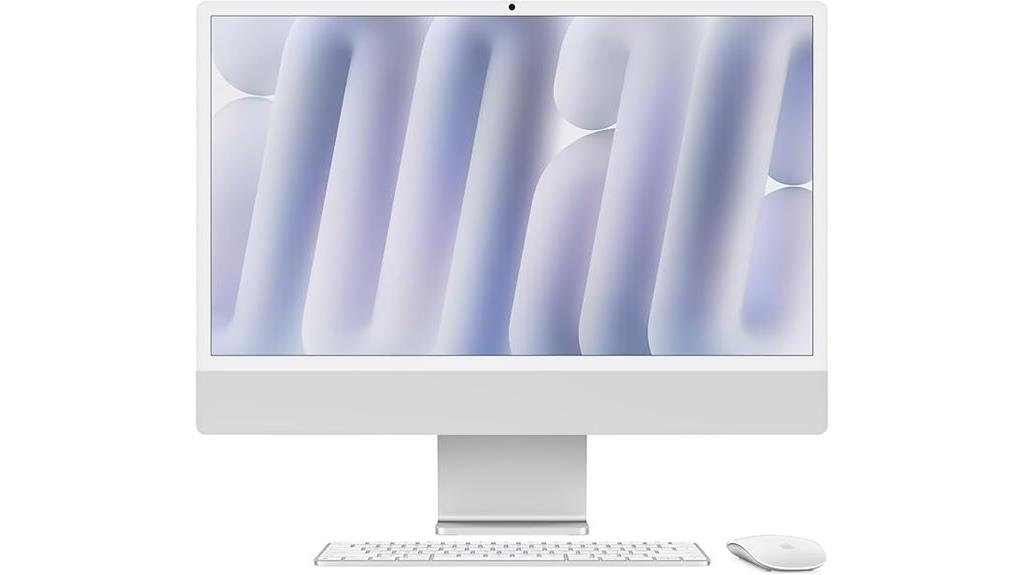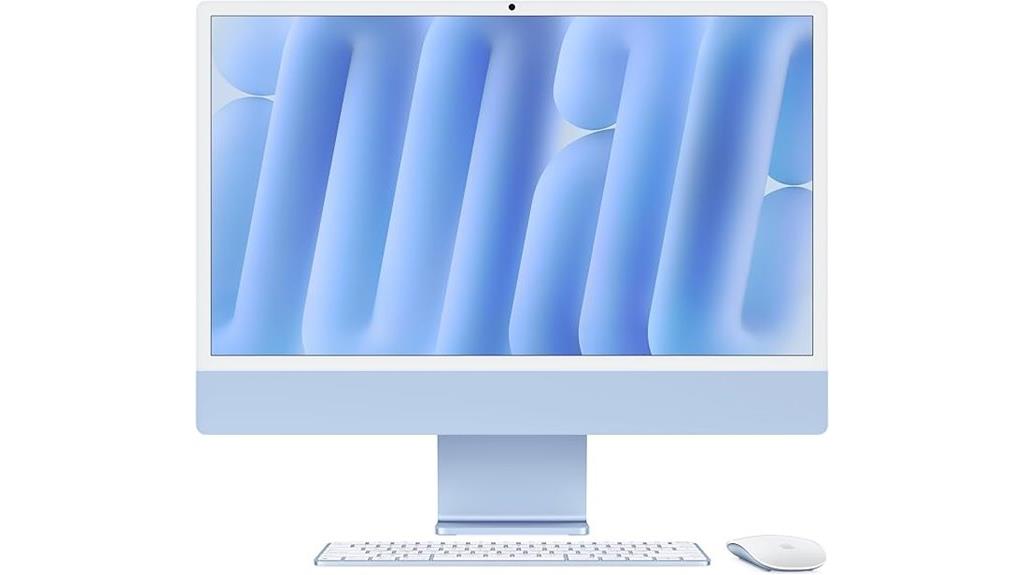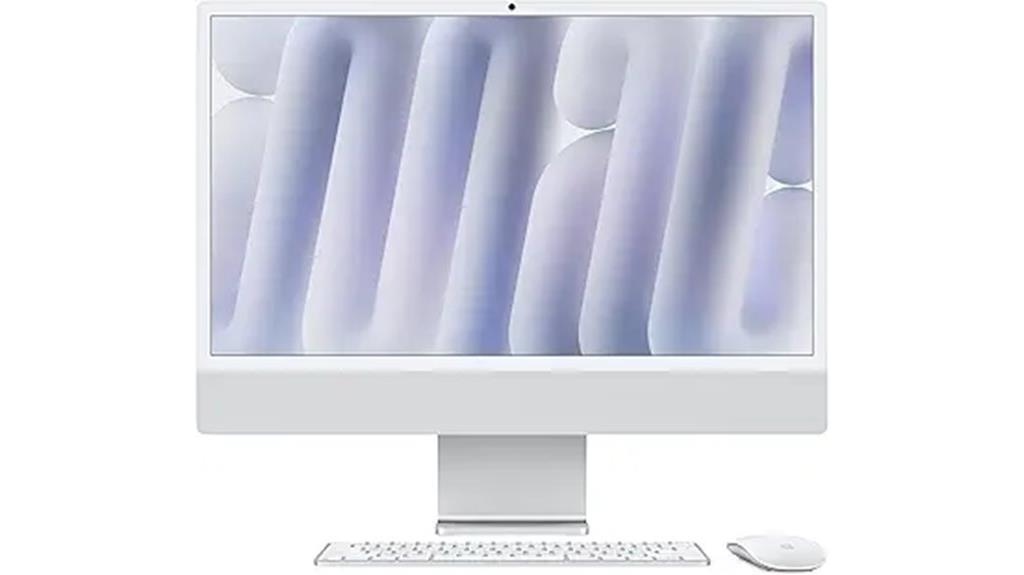If you’re searching for the best iMacs for video editing in 2025, I recommend looking at models powered by the latest M4 chip, offering up to a 10-core CPU and GPU for smooth, demanding workflows. Their stunning 4.5K Retina display provides vibrant visuals, and 16GB of memory guarantees efficient multitasking. While external storage and hubs are often needed, these iMacs balance power, design, and performance perfectly. Keep exploring, and you’ll soon discover which model fits your editing needs best.
Key Takeaways
- Look for iMac models with the latest M4 chip, offering high-performance CPU and GPU options for demanding video editing tasks.
- Prioritize models with at least 16GB of unified memory and ample SSD storage (512GB or more) for smooth workflow.
- Consider 24-inch Retina displays with 4.5K resolution for vibrant visuals and accurate color editing.
- Check connectivity options like multiple USB-C ports and external display support necessary for peripherals.
- Balance budget and performance by selecting higher-end models with advanced processors and larger storage to future-proof editing needs.
Apple 2024 iMac All-in-One Desktop Computer with M4 Chip

If you’re looking for a sleek all-in-one desktop that can handle video editing with ease, the Apple 2024 iMac with the M4 chip is an excellent choice. Its 24-inch Retina display with 4.5K resolution and support for a billion colors offers stunning visuals, perfect for creative work. Powered by the M4 chip with an 8-core CPU and GPU, it ensures fast, smooth performance even with demanding tasks. The 16GB unified memory and 256GB SSD provide quick data access and multitasking efficiency. Plus, its slim, stylish design and vibrant color options make it a space-enhancing centerpiece. This iMac combines beauty with power, ideal for professional editing.
Best For: creative professionals and power users seeking a stylish, high-performance all-in-one desktop for video editing, photo editing, and multitasking.
Pros:
- Stunning 24-inch 4.5K Retina display with support for a billion colors for vibrant visuals
- Powerful M4 chip with 8-core CPU and GPU delivering fast, smooth performance
- Sleek, compact design with vibrant color options that enhance any workspace
Cons:
- Limited to 256GB SSD storage, which may require external storage for large files
- Higher price point compared to some other all-in-one desktops with similar specs
- Limited upgradeability due to integrated hardware design
Apple 2024 iMac Desktop Computer with M4 Chip

The Apple 2024 iMac with the M4 chip stands out as an excellent choice for video editors who need powerful performance in a sleek, space-saving design. Its 24-inch Retina display with 4.5K resolution and support for a billion colors offers stunning visuals, perfect for detailed editing. Powered by the 10-core CPU and GPU, it handles demanding tasks smoothly, while 16GB of unified memory ensures efficient multitasking. The 256GB SSD provides quick data access, and the advanced camera, audio system, and connectivity options make it ideal for professional workflows. Overall, this iMac combines style, performance, and functionality for modern video editing needs.
Best For: creative professionals and video editors seeking a powerful, sleek all-in-one desktop with stunning visuals and efficient performance.
Pros:
- Vibrant 24-inch 4.5K Retina display with support for a billion colors for detailed editing
- Powered by the efficient M4 chip with 10-core CPU and GPU for demanding tasks
- Compact, stylish design that seamlessly fits into any workspace
Cons:
- Limited to 256GB SSD storage, which may require external storage for large projects
- Higher price point compared to some other all-in-one desktops with similar specs
- Limited upgrade options post-purchase due to integrated hardware
Apple 2024 iMac All-in-One Desktop Computer with M4 Chip

For creative professionals seeking a powerful all-in-one computer, the Apple 2024 iMac with M4 chip stands out thanks to its impressive processing speed and stunning Retina display. It features a 10-core CPU and GPU, paired with 16GB of unified memory, ensuring smooth multitasking and fast rendering. The 24-inch 4.5K Retina display supports a billion colors and 500 nits brightness, offering vibrant visuals. Its sleek, colorful design adds personality to any workspace. While port options are limited, external hubs handle additional connectivity needs. Overall, this iMac combines performance, style, and ease of use, making it an excellent choice for video editing and creative workflows.
Best For: creative professionals and small businesses seeking a stylish, powerful all-in-one desktop for multitasking, editing, and creative workflows.
Pros:
- Impressive performance with M4 chip, 10-core CPU and GPU, and 16GB unified memory for smooth multitasking.
- Stunning 24-inch 4.5K Retina display with billion-color support and high brightness for vibrant visuals.
- Sleek, colorful, and modern design that adds personality and style to any workspace.
Cons:
- Limited port options, requiring external hubs or adapters for additional device connectivity.
- Lacks traditional USB ports, which may be inconvenient for some peripherals.
- Cannot support more than two external displays, limiting multi-monitor setups.
Apple 2024 iMac Desktop Computer with M4 Chip

The Apple 2024 iMac Desktop Computer with M4 Chip stands out as an excellent choice for creative professionals who prioritize powerful performance and stunning visuals. Its 10-core CPU and GPU deliver fast processing for editing, multitasking, and creative workflows. The 24-inch Retina 4.5K display supports a billion colors and 500 nits brightness, offering vibrant visuals perfect for video editing. Available in seven vibrant colors, it combines style with functionality. While limited to four USB-C ports, external hubs and SSDs make expanding storage easy. Overall, this iMac’s sleek design and robust performance make it a compelling option for demanding creative work.
Best For: creative professionals and small business users seeking a powerful, visually stunning all-in-one desktop for editing, multimedia, and productivity tasks.
Pros:
- Exceptional performance with M4 chip, 10-core CPU and GPU for demanding workflows
- Vibrant 24-inch Retina 4.5K display with support for a billion colors and high brightness
- Sleek, colorful design that enhances aesthetic appeal and fits various spaces
Cons:
- Limited to four USB-C ports, requiring hubs or adapters for additional peripherals
- External storage solutions needed due to limited internal SSD capacity (512GB)
- Initial setup can be challenging without detailed instructions and the absence of a front Apple icon affects visual symmetry
Apple 2024 iMac All-in-One Desktop Computer with M4 Chip

If you’re looking for a sleek, powerful all-in-one desktop that can handle demanding video editing tasks, the Apple 2024 iMac with M4 chip is an excellent choice. It features a 10-core CPU and GPU, a stunning 24-inch Retina 4.5K display supporting a billion colors, and 24GB of unified memory, ensuring smooth multitasking and fast rendering. Its vibrant, thin design comes in seven colors, fitting beautifully into any workspace. With 512GB SSD storage, it offers quick access to files. While external device support is limited, the system’s performance, stunning visuals, and seamless integration with macOS make it a top contender for creative professionals.
Best For: creative professionals, artists, and power users seeking a sleek, high-performance all-in-one desktop for demanding tasks like video editing, graphic design, and multitasking.
Pros:
- Stunning 24-inch Retina 4.5K display with a billion colors for vibrant visuals
- Powerful M4 chip with 10-core CPU and GPU delivering fast, reliable performance
- Elegant, colorful design available in seven shades that fits well into any workspace
Cons:
- Limited external device support, requiring hubs or adapters for multiple peripherals
- Lack of detailed documentation or setup instructions in the packaging
- External storage options recommended for additional capacity due to SSD size limitations
Apple 2024 iMac Desktop Computer with M4 Chip

The Apple 2024 iMac with M4 chip stands out as an excellent choice for video editors who need powerful, seamless performance combined with stunning visuals. Its 10-core CPU and GPU deliver fast processing, making editing, rendering, and multitasking smooth and efficient. The 24-inch Retina 4.5K display supports a billion colors and has 500 nits brightness, ensuring vibrant, accurate visuals. Its sleek, vibrant design fits well in any workspace, while macOS and Apple’s ecosystem provide smooth app compatibility. Although limited ports mean external hubs are necessary, the overall speed, reliability, and stunning display make this iMac a compelling option for creative professionals.
Best For: creative professionals, particularly video editors and digital artists, seeking a powerful, visually stunning all-in-one desktop with seamless performance and Apple ecosystem integration.
Pros:
- Exceptional 24-inch Retina 4.5K display with vibrant colors and high brightness for accurate visuals
- Powered by the efficient M4 chip with a 10-core CPU and GPU, ensuring fast processing and multitasking
- Sleek, vibrant design available in multiple colors that enhances workspace aesthetics and user experience
Cons:
- Limited external connectivity with only four USB-C ports, requiring hubs or adapters for additional peripherals
- Internal storage options may be limited; external SSDs recommended for expanded storage needs
- Initial setup can be challenging and may lack detailed instructions, which could affect first-time users
Factors to Consider When Choosing an Imac for Video Editing

When choosing an iMac for video editing, I consider several key factors to make certain it meets my needs. I look at processing power, display quality, memory, storage, connectivity options, and graphics capabilities. Focusing on these points helps me pick a machine that handles demanding projects smoothly.
Processing Power Needs
Choosing a powerful processor is essential for smooth video editing, as it directly impacts rendering, encoding, and playback performance. A multi-core CPU, like an 8-core or 10-core, can substantially cut down editing and rendering times, making workflows more efficient. Faster processors also improve multitasking, allowing me to export videos in the background while working on other projects without lag. While the CPU is crucial, GPU performance also plays a critical role, accelerating tasks like color grading and effects. Guaranteeing the processor meets or exceeds the software’s recommended specifications guarantees a seamless editing experience. Investing in a high-performance processor ensures I can handle demanding tasks smoothly, saving time and reducing frustration during intensive editing sessions.
Display Quality Standards
A high-quality display is crucial for effective video editing, as it directly impacts how accurately I can see and evaluate colors, details, and overall image quality. For this, I look for a resolution of at least 4.5K or higher, ensuring sharp, detailed visuals. Supporting up to a billion colors allows for precise color grading and vibrant, true-to-life images. Brightness levels of 500 nits or more improve visibility in various lighting conditions, aiding accurate adjustments. An IPS or Retina display offers wide viewing angles and consistent color accuracy across different perspectives. Additionally, support for wide color gamuts like P3 ensures a broader spectrum of colors, making my videos more realistic and vivid. These standards are essential for professional-quality video editing.
Memory and Storage
High-quality display standards set the foundation for accurate video editing, but without sufficient memory and storage, even the best visuals can become difficult to work with. I recommend at least 16GB of unified memory to handle large files and multitasking smoothly. More RAM speeds up rendering and reduces lag during intensive tasks. Storage is equally vital; opting for 512GB or higher ensures you can store high-resolution videos and project assets without constantly relying on external drives. While internal SSDs are fast, they can fill up quickly with large video files, so considering external SSDs for expanded storage is wise. Adequate internal storage allows quick access to media, streamlining the editing process and preventing workflow interruptions.
Connectivity Options
Since most recent iMac models mainly feature USB-C ports, evaluating connectivity options is vital for a smooth video editing workflow. USB-C ports are versatile, but they often require adapters or hubs for traditional USB-A devices like external drives, cards, or microphones. External storage solutions, such as SSDs, connect via USB-C, making port availability essential for fast data transfer during large file edits. Additionally, these iMacs typically support only up to two external displays, which can limit multi-monitor setups indispensable for editing accuracy and multitasking. The lack of standard USB ports means planning for compatible hubs or docks is necessary to connect multiple peripherals seamlessly. Overall, understanding the number and type of ports helps guarantee your workflow remains efficient and flexible.
Graphics Capabilities
With most recent iMac models focusing on USB-C connectivity, it’s important to also consider their graphics capabilities for video editing. A powerful GPU is vital for smooth playback, fast rendering, and handling high-resolution footage like 4K or 8K. Higher GPU core counts boost performance in color grading, effects, and real-time editing tasks. Supporting HDR and extensive color data demands a graphics system that can manage luminance and color variations effectively. For more demanding projects, integrated graphics might fall short, making external GPU options a smart upgrade. Overall, the iMac’s graphics capabilities—core count, support for external displays, and rendering speed—are key factors that directly influence workflow efficiency and final quality in video editing.
Port Availability
Choosing the right iMac for video editing means paying close attention to port availability, as it directly impacts your workflow. You’ll want enough USB-C or Thunderbolt ports to connect external drives, monitors, and peripherals simultaneously without constantly swapping cables. Check if the iMac supports multiple external displays, especially if your editing setup requires more than two monitors. If port options are limited, consider hubs or dongles to connect standard USB-A devices and other accessories. High-speed data transfer options like Thunderbolt 4 are essential for handling large video files efficiently. Keep in mind that some models lack traditional USB ports, so you’ll need adapters for external storage and input devices. Ensuring sufficient, versatile ports helps streamline your editing process and boosts productivity.
Budget Considerations
Budget considerations play a significant role in selecting the right iMac for video editing, especially when balancing performance needs with financial constraints. Higher-end models with faster processors and larger SSDs come at a premium, impacting the overall cost. Remember to include expenses for accessories like external drives, hubs, or adapters, which are essential for a complete setup. Entry-level iMacs may be more affordable initially but often lack the processing power and memory needed for demanding editing tasks, potentially requiring upgrades sooner. Limited budgets might also restrict color options or advanced features, affecting performance and aesthetics. However, investing in a more capable iMac upfront can boost editing efficiency and lower long-term upgrade costs, making it a smarter financial choice.
Frequently Asked Questions
How Does the M4 Chip Improve Video Editing Performance?
The M4 chip markedly boosts my video editing performance by offering faster processing speeds and improved graphics. Its advanced architecture handles high-resolution footage seamlessly, reducing render times and lag. I notice smoother playback and quicker exports, even with complex projects. The power efficiency also helps my Mac run cooler, allowing me to work longer without overheating. Overall, the M4 chip makes editing more efficient and enjoyable.
What Display Features Are Essential for Professional Video Editing?
Think of a display as the window to your creative world. For professional video editing, I look for a high-resolution screen with accurate color reproduction, like 10-bit or higher color depth. Essential features include a wide P3 color gamut, true HDR support, and a matte or anti-reflective coating to diminish glare. These elements ensure my edits are precise, consistent, and true to life, making my workflow smooth and visually stunning.
Are Upgrade Options Available for Storage and RAM in 2025 Imacs?
Yes, upgrade options for storage and RAM are available in 2025 iMacs. I recommend checking the specific model you’re interested in, as some allow user upgrades while others do not. Typically, more RAM and larger SSDs enhance editing performance. If you’re planning to upgrade, do so early, since some models might have soldered RAM or non-upgradable storage, making future upgrades impossible.
How Does Cooling Impact Imac Performance During Intensive Editing Tasks?
Cooling is the unsung hero during intensive editing sessions; it keeps my iMac running smoothly without overheating. When the system stays cool, I notice fewer lags and crashes, which means I can work longer without interruption. Proper cooling prevents thermal throttling, maintaining peak performance. If an iMac gets too hot, it’s like hitting a wall—performance drops. Good airflow and cooling solutions are essential for seamless, high-quality editing.
What Software Compatibility Issues Might Arise With 2025 Imacs?
I’ve noticed that with 2025 iMacs, software compatibility can sometimes be tricky, especially with older editing programs still optimized for previous macOS versions. Some plugins or workflows might not immediately work, requiring updates or alternative tools. I recommend checking software developer websites for compatibility info and ensuring your editing tools are up-to-date to avoid workflow disruptions. Staying current helps prevent headaches during intensive editing sessions.
Conclusion
Choosing the right iMac for video editing in 2025 is like selecting a precision instrument or a powerful canvas. Each model offers a blend of speed, clarity, and sleek design, much like a craftsman’s tool or an artist’s brush. Whether you need raw power or refined detail, the perfect iMac balances performance with elegance. Ultimately, it’s about finding that harmony where your creative vision meets cutting-edge technology.










